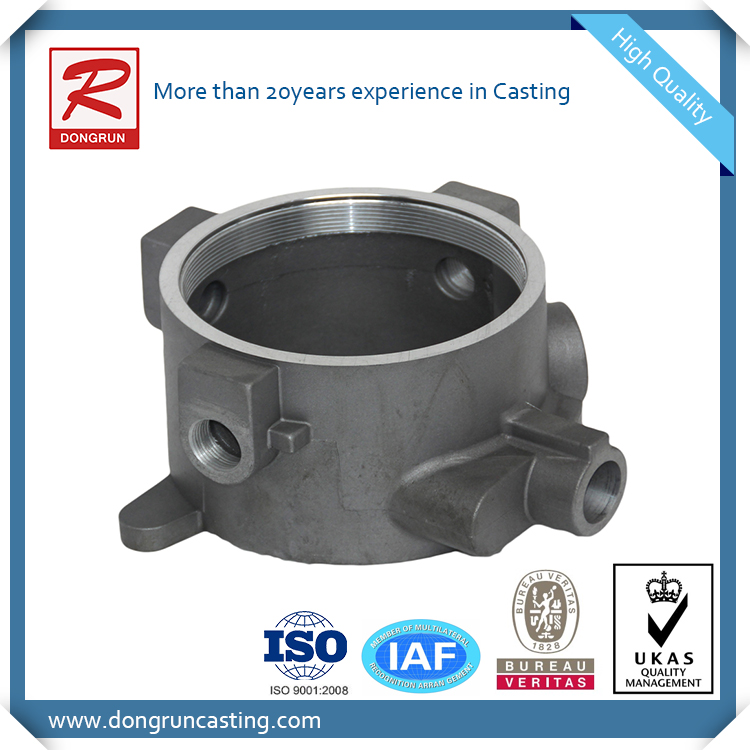Permanent mold casting process for Hydraulic Industries Parts

Permanent mold casting is a highly effective process used in the manufacturing of hydraulic industry parts, particularly when producing components that require high strength, precise dimensions, and excellent surface finish. This casting method involves the use of reusable molds, typically made from steel or other durable materials, which are used to produce multiple castings.
Key Steps in the Permanent Mold Casting Process:
Mold Design and Preparation:
Mold Creation: The process begins with designing and creating the permanent mold, typically made from steel, cast iron, or other durable materials. The mold is precisely machined to match the design specifications of the hydraulic component.
Surface Treatment: The mold is coated with a refractory material to protect it from thermal shock and to facilitate the release of the cast part after solidification. This coating also enhances the surface finish of the final product.
Preheating the Mold:
Before pouring the molten metal, the mold is preheated to a specific temperature. Preheating helps reduce the thermal gradient between the molten metal and the mold, minimizing the risk of defects such as shrinkage and cold shuts.
Melting and Pouring:
Molten Metal Preparation: The metal, often aluminum, magnesium, or other non-ferrous alloys, is melted in a furnace to the desired casting temperature.
Pouring: The molten metal is then poured into the preheated permanent mold under gravity, though in some cases, low-pressure or vacuum assistance may be used to improve metal flow and reduce air entrapment.
Solidification and Cooling:
Controlled Cooling: The metal solidifies as it cools within the mold. The cooling rate is relatively fast due to the thermal conductivity of the metal mold, which results in a fine-grain structure and enhanced mechanical properties in the cast part.
Directional Solidification: The design of the mold and the cooling process can be managed to promote directional solidification, reducing the likelihood of internal defects and ensuring higher-quality parts.
Mold Opening and Part Removal:
Once the metal has fully solidified, the mold is opened, and the cast part is removed. Since the mold is reusable, it can be closed and prepared for the next cycle immediately after part removal.
Post-Casting Operations:
Trimming: Excess material, such as sprues and risers, is removed from the cast part.
Heat Treatment: Depending on the material and application, the cast parts may undergo heat treatment to enhance mechanical properties like strength and hardness.
Machining: While permanent mold casting provides good dimensional accuracy, final machining may be required for critical dimensions or to meet tight tolerances.
Inspection: The finished parts are inspected for any defects or inconsistencies. Non-destructive testing methods such as X-ray or ultrasonic testing may be used to ensure internal integrity.
Advantages of Permanent Mold Casting for Hydraulic Parts:
High Precision and Dimensional Accuracy:
Permanent mold casting produces parts with tight tolerances and excellent surface finishes, reducing the need for extensive post-casting machining.
Improved Mechanical Properties:
The rapid solidification associated with permanent mold casting results in a fine-grained microstructure, leading to superior strength, toughness, and wear resistance, which are critical for hydraulic components.
Reusability of Molds:
The durability of the mold materials allows for multiple uses, making the process cost-effective for medium to high production volumes.
Reduced Porosity:
The controlled cooling and solidification process helps reduce the formation of porosity and other internal defects, ensuring the reliability of hydraulic components under high-pressure conditions.
Consistency and Repeatability:
Permanent mold casting is ideal for producing consistent and repeatable parts, which is crucial for hydraulic systems where uniformity in component performance is necessary.
Applications in Hydraulic Industries:
Permanent mold casting is widely used in the hydraulic industry to produce a variety of critical components, including:
Pumps and Valves: The process is ideal for manufacturing pump housings, valve bodies, and other components that require high dimensional accuracy and durability.
Cylinder Heads and Bodies: Hydraulic cylinder components benefit from the strength and precision provided by permanent mold casting, ensuring long service life and reliable performance.
Fittings and Connectors: The process is used to produce high-quality hydraulic fittings, connectors, and couplings, which require leak-proof performance under high pressure.
Conclusion:
Permanent mold casting is a valuable process for the hydraulic industry, offering high-quality, reliable components with excellent mechanical properties. The precision, consistency, and efficiency of this casting method make it well-suited for producing the critical parts needed to ensure the performance and safety of hydraulic systems.
Dongrun Casting has 20000 square meters of facility houses and 200 production & test equipment, From quotation and tooling design to casting and finished machining, we can work with you at every stage. We serve a wide range of industries-from Fortune 500 corporations to small and midsize OEMs. Our products include Automotive&trucking, Electric Utility & Communications, Metering Systems, the Hydraulic Industry, Medical Devices, Lighting, Fuel and Gas Pressure, and Furniture parts.
More Details: www.dongruncasting.com
